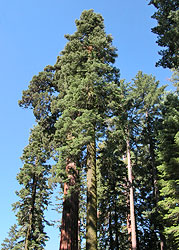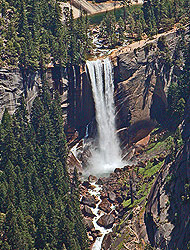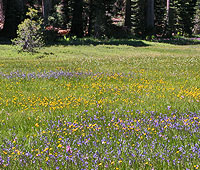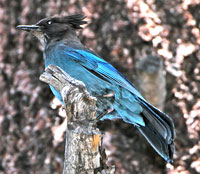Yosemite National Park

 |
| The oldest Sequoia trees are believed to be
about 3000 years old. |
Yosemite National
Park is located in the central Sierra Nevada of California and lies 150
miles east of San Francisco and only a six hour drive from Los Angeles.
Designated a World Heritage Site in 1984, Yosemite is internationally
recognized for its spectacular granite cliffs, waterfalls, clear streams,
giant sequoia groves, and biological diversity. The 750,000-acre, 1,200
square-mile park contains thousands of lakes and ponds, 1600 miles of
streams, 800 miles of hiking trails, and 350 miles of roads. Two federally
designated wild and scenic rivers, the Merced and Tuolumne, begin within
Yosemite's borders and flow west into California's Central Valley. Annual
park visitation exceeds 3.5 million, with most visitor use concentrated
in the seven square mile area of Yosemite Valley.
 |
| Vernal Falls with a drop of 317 feet. |
The geology of Yosemite
is characterized by granitic rocks and remnants of older rock. About 10
million years ago, the Sierra Nevada was uplifted and then tilted to form
its relatively gentle western slopes and the more dramatic eastern slopes.
The uplift increased the steepness of stream and river beds, resulting
in formation of deep, narrow canyons. About 1 million years ago, snow
and ice accumulated, forming glaciers at the higher alpine meadows that
moved down the river valleys. Ice thickness in Yosemite Valley may have
reached 4,000 feet during the early glacial episode. The downslope movement
of the ice masses cut and sculpted the U-shaped valley that attracts so
many visitors to its scenic vistas today.
 |
| Meadow of Wildflowers. |
Yosemite is one of
the largest and least-fragmented habitat blocks in the Sierra Nevada,
and it supports a diversity of plants and wildlife. The park has an elevation
range from 2,000 to 13,123 feet and contains five major vegetation zones:
chaparral/oak woodland, lower montane, upper montane, subalpine and alpine.
Of California's 7,000 plant species, about 50% occur in the Sierra Nevada
and more than 20% within Yosemite. There is suitable habitat or documented
records for more than 160 rare plants in the park, with rare local geologic
formations and unique soils characterizing the restricted ranges many
of these plants occupy.
 |
| Steller's Jay. |
Yosemite has more
than 300 species of vertebrate animals, and 85 of these are native mammals.
Black bears are abundant in the park, and are often involved in conflicts
with humans that result in property damage and, occasionally, injuries
to humans. Visitor education and bear management efforts have reduced
the bear-human incidents and property damage by 90% in the past few years.
Ungulates include large numbers of mule deer. Bighorn sheep formerly populated
the Sierra crest, but have been reduced to several remnant populations.
There are 17 species of bats, 9 of which are either Federal or California
Species of Special Concern. Over 150 species of birds regularly occur
in the parks. Great gray owls are of special interest in Yosemite because
here they reach the furthest southern extent of their global range, and
they are isolated by hundreds of miles from the next closest population
in far northern California.
(Much of the information in this section was adapted from resources
provided by Yosemite National Park.)
Copyright © 2004-2006 Calvin & Rosanna Hamilton. All rights reserved.




